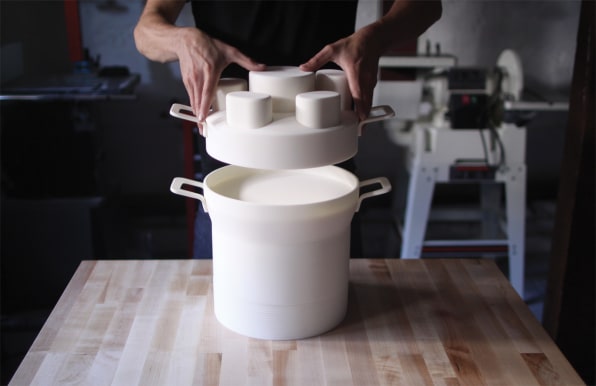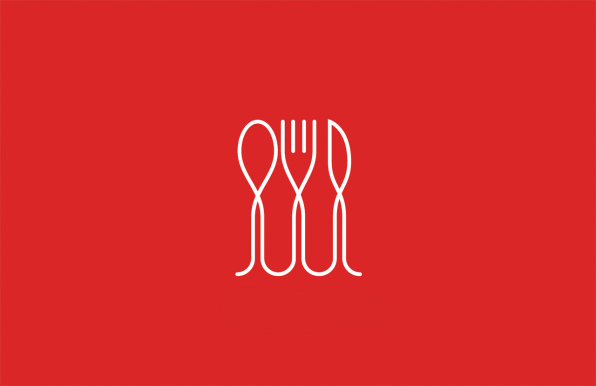Food Network Brand Slow Cooker
Before sous vide machines migrated from fine dining to domestic domains, before Keurigs and "The Keurig of Xs" began cluttering countertops, and before we started pulverizing food into a textureless slurry, there was one piece of culinary tech that took America by storm: the humble crock pot.
When Irving Naxon introduced the electric slow cooker to the market in the 1950s, it was touted as a liberating device that allowed women to prepare food in the morning, leave for work during the day, and still have a plate of hot food ready in the evening. In the 1970s, it was championed as an an efficient cooking method in the wake of the energy crisis. Today, we often associate it with vast amounts of food that, while tasty, all comes out to have the same mushy, amalgamated consistency.
Companies have tried to update the slow cooker for the IoT era (but who needs to control one from an app? the point is you don't need to manage it once it gets going…) without much consideration to the role the appliance plays or what people want to get out of a modernized, app-fueled version of the kitchen gadget.
Enter Oliver, a new slow cooker designed by the San Francisco consultancy Matter. The product is two-fold: a sleek, compact countertop appliance and an app.
The product's inventor, Khalid Aboujassoum, came up with the idea and presented it on Stars of Science (kind of like Qatar's version of Shark Tank). The prototype was rough, but set forth the core proposition: a device with multiple chambers that releases the ingredients into a cooker to ensure meats, veggies, and grains all come out at the optimal texture. Throughout the development process, Aboujassoum and his team collaborated closely with Matter to ensure that the engineering and aesthetic elements of the product supported one another.

"They had this prototype that looked like a piece of machinery," Adam Leonards, a creative director at Matter, says. "If you talked to another industrial design firm, it would be about making it look prettier. We started to look at what does cooking mean? What are the paradigms people have for cooking?"
Judging from the slew of cooking documentaries coming from Netflix, the rise of celebrity chefs who are outright lifestyle brands, and the popularity of the Food Network, we're all becoming more adventurous in the kitchen, a fact reinforced by our insatiable hunger for exotic hot sauces. Matter looked at the trends and saw that the type of person who would be most interested in an automatic cooker is someone who likely lives in a city and leads a busy life. Moreover, that person wants to eat food that's healthy, that tastes as good as what you'd find at a restaurant, and nearly as easy to use as calling for take-out.

"I think there's a broader general movement, especially in Western cultures, to be more connected to the food we put into our bodies as well as in the cultural part of sharing a meal with friends and family," Max Burton, Matter's founder and chief designer, says. "People want those things, but they don't want to lose the convenience. They also don't want it to be difficult and challenging. It's a fine line this product resolves."
There's also the challenge of recipe discovery. While there's plenty of food porn out there on blogs, finding the right recipe and executing it well can be problematic.
Using Oliver starts and ends with its app. First, you search through its recipe database which features cuisines from all around the world. Once you settle on a dish, the app tells you what ingredients you should buy and how to cut and chop them before placing them into one of the appliance's six canisters. You then place the canisters into their respective loading areas. Keeping ingredients separate until it's time to cook them is important. A potato doesn't have the same cooking time as chicken, for example, so the machine knows when to drop everything into the main cooking unit.

The canister tray fits over the pot just like a lid–a conscious decision to make the experience as close to using a traditional pot as possible. The pot, which has an internal stirring mechanism, then sits over the warming element. There are no controls on the pot, just a backlit LED countdown clock that disappears when it's off–a detail pulled from the Nike Fuelband that helps to keep the product clean and simple and to avoid looking outdated over time.
Inventing a new kitchen gadget with staying power is somewhat challenging, especially in the Marie Kondo era of limiting what we own to the essentials. With a cast iron pan and a chef's knife you can make just about anything. And how many of us regularly pull out blenders and food processors anyway? That said, every chef has his dream gadget.
"A lot of people put off making new meals because they don't have the time or patience to learn how," Burton says. "This opens up the door. Through the app, you can explore the world."
That's a proposition your potato peeler won't be making anytime soon.
Update: Oliver will begin a pilot program in September, but is not yet available for sale.
Food Network Brand Slow Cooker
Source: https://www.fastcompany.com/3061096/a-slow-cooker-for-a-generation-raised-on-the-food-network
Posted by: navawhistaket.blogspot.com

0 Response to "Food Network Brand Slow Cooker"
Post a Comment